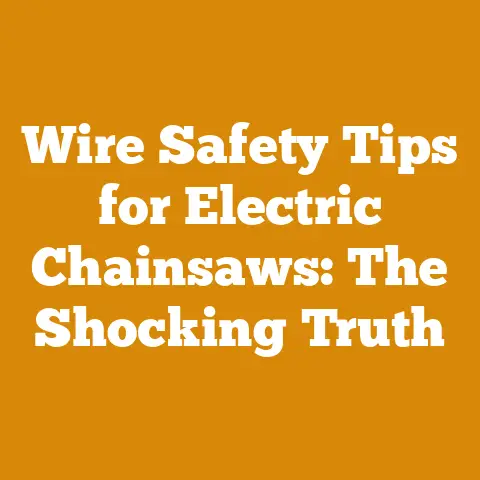Guarding Your Chainsaw from Damaging Voltage Surges (Guide)
Operating a chainsaw brings great satisfaction and efficiency when cutting and pruning trees or harvesting firewood. However, like any power tool, chainsaws can experience electrical issues leading to frustrating performance problems. One of the most common electrical gremlins affecting chainsaws is damaging voltage surges.
Voltage spikes from an unstable power supply can have severe consequences for your chainsaw. At best, nuisance tripping of the safety breaker may interrupt your work. At worst, voltage surges can fry the internal electronics and wiring – resulting in costly repairs or premature tool death.
By understanding what causes voltage surges, learning to recognize the symptoms, and applying preventative maintenance habits – you can protect your chainsaw investment and ensure smooth operation. This guide will explore the hazards of voltage spikes and provide actionable solutions to keep your chainsaw running safely.
What Causes Voltage Surges in Chainsaws?
Voltage surges occur when there is a sudden, brief increase in the electrical supply flowing to your power tool. There are several potential causes:
- Switching on/off high-powered appliances – like refrigerators or air conditioners – in the same circuit can create power dips and spikes.
- Lightning strikes on the electrical grid, or your home wiring, induces massive voltage fluctuations.
- Failing transformers and issues with utility equipment leads to uneven power delivery.
- Connecting an extension cord while the chainsaw is running creates fluctuations.
- Using excessively long or thin gauge extension cords leads to voltage drop then surge when reconnected.
Recognizing the Symptoms of Voltage Spikes
Catching voltage spike issues early allows you to take preventative action before major damage occurs. Here are key signs your chainsaw is suffering surges:
- Power loss or abrupt shutoff without triggering the breaker.
- Lights dimming or flickering in your home when starting your chainsaw.
- Chainsaw not reaching full speed, sputtering, or stopping unexpectedly.
- Motors or electronics overheating despite normal operation.
- Unusual noises from the motor, like squealing or grinding.
- Smoke or burning smell from the chainsaw housing or wiring.
- Tripping of the safety breaker without overloading the circuit.
- Failure to restart after abrupt shutoff, or odd electrical behavior.
Any of these warning signs should prompt you to investigate likely sources of voltage surges and install preventative protections. It’s much easier to address minor electrical issues before catastrophic failure.
Step-by-Step Solutions: Guarding Against Voltage Spikes
- Verify adequate circuit capacity – Chainsaws draw a lot of power. Ensure you are operating on a dedicated 20A circuit with sufficient headroom.
- Eliminate extension cord use – Plug your chainsaw directly into the outlet to maintain steady voltage. Avoid disconnecting/reconnecting when running.
- Install surge suppressor – Add specific surge protecting outlets or a whole home suppressor at your breaker panel. This absorbs spikes.
- Use voltage meter – Monitor the supply voltage looking for fluctuations when operating the chainsaw and other appliances simultaneously.
- Consult an electrician – For older homes or problematic circuits, professional electrical upgrades may be needed.
- Replace worn cords/plugs – Faulty, damaged or inadequate gauge cords cause voltage drop and instability. Upgrade to 10-12 AWG.
- Rule out chainsaw issues – Malfunctioning chainsaw electronics or brush wear on motors can mimic symptoms of voltage spikes. Test or repair.
- Optimize circuit layout – Position outlets close to the breaker panel and use the shortest branch circuits to minimize voltage drop.
- Match tool and circuit wattage – Overloading a circuit forces too much current flow for the gauge wire, risking heat damage.
- Add hardwired surge protector – At the breaker panel, a whole home protector provides robust protection from surges.
DIY Voltage Spike Repairs to Stabilize Your Supply
With basic DIY electrical skills, you can tackle several repairs and improvements to protect against voltage surges:
1. Upgrade extension cords – Replace light duty cords with 10-12 AWG heavy duty types that won’t cause voltage drop. Ensure high quality, sturdy connectors too.
2. Test outlet grounding – Use a circuit tester to confirm proper outlet grounding. Ungrounded outlets leave you vulnerable to surges. Ground or replace faulty outlets.
3. Clean electrical contacts – Remove and clean contacts on plugs, surge strips and outlets to clear gritty buildup that impedes consistent contact.
4. Upgrade breaker panel – Aging breaker panels may lack surge suppression. Replacing the entrance panel provides modern protection.
5. Increase wire gauge on branch circuits – For distant shop buildings, longer 14 AWG feed wires cause voltage drop. Upgrade to 10 AWG for stable voltage over distance.
6. Replace worn power switch – If your chainsaw power switch shows pitting or electrical arching, replace it to avoid faulty operation during surges.
7. Add dedicated chainsaw circuit – For the workshop, install a dedicated 20A circuit with short wire runs to minimize voltage variability affecting your saw.
Preventative Maintenance Against Chainsaw Voltage Surges
Making smart operating choices optimizes electrical supply stability for your chainsaw:
- Shut down adjacent high-draw appliances when operating your chainsaw to avoid cycling on/off loads.
- Maintain distance between the chainsaw power cord and other cables to minimize electromagnetic interference.
- Position the chainsaw outlet as close to the home’s electrical panel as possible for minimal voltage drop.
- Disconnect extension cords before starting the chainsaw to prevent connection spikes.
- Use the shortest, heaviest gauge extension cord possible and ensure tight connections.
- Avoid chainsaw use during electrical storms which induce powerful voltage surges.
- Use a backup power supply like a generator for outdoor operation away from clean power sources.
- On older homes, hire an electrician periodically to verify stable voltage to all shop or outdoor outlets.
Warning Signs of an Imminent Chainsaw Failure from Voltage Spikes
Catching damaging voltage surges in time to prevent permanent damage requires awareness of the warning signs:
- Chainsaw failing to reach operating RPM, bogging down under load
- Intermittent tripping of the safety breaker or blown fuses
- Motor overheating and smoking from repeated restart attempts
- Melting of insulation on wires entering the chainsaw housing
- Arcing or pitted contacts on the power switch
- Discoloration of circuits or electronics indicating overheating
- Loose internal chainsaw components from vibration
- Family of appliances downstream of the chainsaw also malfunctioning
When you notice any of these issues, it’s time to thoroughly diagnose the power supply feeding your chainsaw before resuming operation. Addressing small problems quickly can help avoid safety hazards and permanent electrical damage.
Diagnosing and Locating the Source of Voltage Surges
Start voltage surge troubleshooting by process of elimination:
1. Check extension cords – Try plugging the chainsaw directly into a known good outlet without cords to rule out their deficiencies. Inspect for damage, loose plugs, and insufficient gauge.
2. Verify outlet voltage – Use a voltage meter to check for steady 120V supply during chainsaw startup and cut cycles. Fluctuations point to external power issues.
3. Monitor other appliances – Note if lights dim or other tools grind to a halt briefly when starting the chainsaw. Indicates overloaded circuit.
4. Eliminate chainsaw defects – Inspect brushes, armature, bearings and wiring for malfunctions mimicking voltage surges. Test or repair the saw.
5. Switch to different circuit – Try chainsaw in another part of your home in case a particular circuit has electrical issues.
6. Consult an electrician – For whole home voltage mysteries, hire a professional electrician to fully evaluate your circuits, wiring, and grounding.
Protecting a Chainsaw from Further Damage
If your chainsaw is suffering reliability issues from voltage spikes, Here are tips to limit further damage as you troubleshoot:
- Stop using extension cords which exacerbate voltage drop and instability.
- Connect the chainsaw on a different branch circuit away from appliances causing cycling loads.
- Install surge suppressing outlets or a whole home surge arrestor as a precaution until the issue is resolved.
- Use a voltage meter to verify power supply before each use.
- Avoid operating the chainsaw during hot weather when voltage drops due to high A/C load.
- Replace burnt, melted or damaged power cords and internal wiring immediately.
- Be prepared to replace brushes and bearings if arcing has occurred.
- Back up critical chainsaw usage with a generator or battery-powered alternative.
- Rewind and inspect the armature for hot spots or shorts indicating damage.
Protecting your investment starts with preventative maintenance and being alert to early symptoms of electrical issues. Addressing voltage surge problems promptly can add years of life to your valuable chainsaw







